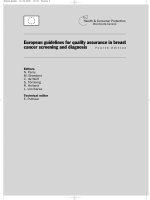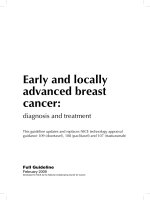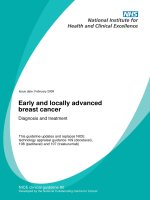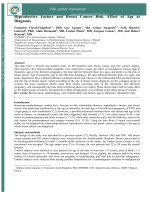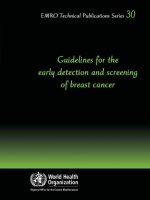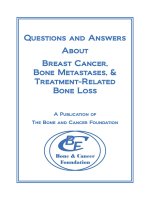Early and locally advanced breast cancer - Diagnosis and treatment pdf
Bạn đang xem bản rút gọn của tài liệu. Xem và tải ngay bản đầy đủ của tài liệu tại đây (233.95 KB, 37 trang )
Issue date: February 2009
NICE clinical guideline 80
Developed by the National Collaborating Centre for Cancer
Early and locally advanced
breast cancer
Diagnosis and treatment
This guideline updates and replaces NICE
technology appraisal guidance 109 (docetaxel),
108 (paclitaxel) and 107 (trastuzumab)
NICE clinical guideline 80
Early and locally advanced breast cancer: diagnosis and treatment
Ordering information
You can download the following documents from www.nice.org.uk/CG80
• The NICE guideline (this document) – all the recommendations.
• A quick reference guide – a summary of the recommendations for
healthcare professionals.
• ‘Understanding NICE guidance’ – a summary for patients and carers.
• The full guideline – all the recommendations, details of how they were
developed, and reviews of the evidence they were based on.
For printed copies of the quick reference guide or ‘Understanding NICE
guidance’, phone NICE publications on 0845 003 7783 or email
and quote:
• N1792 (quick reference guide)
• N1793 (‘Understanding NICE guidance’).
NICE clinical guidelines are recommendations about the treatment and care of
people with specific diseases and conditions in the NHS in England and
Wales.
This guidance represents the view of NICE, which was arrived at after careful
consideration of the evidence available. Healthcare professionals are
expected to take it fully into account when exercising their clinical judgement.
However, the guidance does not override the individual responsibility of
healthcare professionals to make decisions appropriate to the circumstances
of the individual patient, in consultation with the patient and/or guardian or
carer, and informed by the summary of product characteristics of any drugs
they are considering.
Implementation of this guidance is the responsibility of local commissioners
and/or providers. Commissioners and providers are reminded that it is their
responsibility to implement the guidance, in their local context, in light of their
duties to avoid unlawful discrimination and to have regard to promoting
equality of opportunity. Nothing in this guidance should be interpreted in a way
that would be inconsistent with compliance with those duties.
National Institute for Health and Clinical Excellence
MidCity Place
71 High Holborn
London WC1V 6NA
www.nice.org.uk
© National Institute for Health and Clinical Excellence, 2009. All rights reserved. This material
may be freely reproduced for educational and not-for-profit purposes. No reproduction by or
for commercial organisations, or for commercial purposes, is allowed without the express
written permission of NICE.
Early and locally advanced breast cancer:
diagnosis and treatment
NICE guideline
February 2009
This guideline updates and replaces technology appraisals 109 (published
September 2006), 108 (published September 2006) and 107 (published
August 2006).
Contents
Introduction 7
Patient-centred care 8
Key priorities for implementation 9
Guidance 12
1.1 Referral, diagnosis and preoperative assessment 12
1.2 Providing information and psychological support 13
1.3 Surgery to the breast 13
1.4 Surgery to the axilla 14
1.5 Breast reconstruction 15
1.6 Postoperative assessment and adjuvant therapy planning 15
1.7 Endocrine therapy 16
1.8 Chemotherapy 18
1.9 Biological therapy 18
1.10 Assessment and treatment of bone loss 19
1.11 Radiotherapy 19
1.12 Primary systemic therapy 22
1.13 Complications of local treatment and menopausal symptoms 22
1.14 Follow-up 24
2 Notes on the scope of the guidance 26
3 Implementation 27
4 Research recommendations 28
4.1 Psychological support 28
4.2 Optimum treatment of the axilla 28
4.3 Trastuzumab 29
4.4 Radiotherapy 30
4.5 Follow-up mammography 30
5 Other versions of this guideline 32
5.1 Full guideline 32
5.2 Quick reference guide 32
5.3 ‘Understanding NICE guidance’ 32
6 Related NICE guidance 32
7 Updating the guideline 34
Appendix A: The Guideline Development Group 35
Appendix B: The Guideline Review Panel 37
NICE clinical guideline 80 – Early and locally advanced breast cancer 7
Introduction
Breast cancer is the most common cancer for women in England and Wales,
with about 40,500 new cases diagnosed
1,
2
This guideline recommends some drugs for indications for which they do not
have a UK marketing authorisation at the date of publication, as there is good
evidence to support that use. Unlicensed drugs are marked with a footnote.
and 10,900 deaths
1, 2
recorded in
England and Wales each year. In men breast cancer is rare, with about 260
cases diagnosed
1, 2
and 68 deaths
1, 2
in England and Wales each year. Of
these new cases in women and men, a small proportion are diagnosed in the
advanced stages, when the tumour has spread significantly within the breast
or to other organs of the body. In addition, a considerable number of women
who have been previously treated with curative intent subsequently develop
either a local recurrence or metastases.
Early breast cancer is subdivided into two major categories, in situ disease,
mainly in the form of ductal carcinoma in situ (DCIS), and invasive cancer.
Both are heterogeneous processes with very variable appearances, biology
and clinical behaviour.
Over recent years there have been important developments in the
investigation and management of breast cancer including new types of
chemotherapy, and biological and hormonal agents. There is some evidence
of practice variation across the country and of inconsistent availability of
certain treatments and procedures. This clinical guideline helps to address
these issues and offers guidance on best practice.
This guideline assumes that prescribers will use a drug’s summary of product
characteristics to inform their decisions for individual patients.
1
Office for National Statistics (2008) Cancer statistics registrations: registrations of cancer
diagnosed in 2005, England. Series MB1 number 36. London: Office for National Statistics.
2
Welsh Cancer Intelligence and Surveillance Unit (2008) Cancer incidence in Wales. Cardiff:
Welsh Cancer Intelligence and Surveillance Unit.
NICE clinical guideline 80 – Early and locally advanced breast cancer 8
Patient-centred care
This guideline offers best practice advice on the care of patients with early or
locally advanced breast cancer.
Treatment and care should take into account patients’ needs and preferences.
Patients with early or locally advanced breast cancer should have the
opportunity to make informed decisions about their care and treatment, in
partnership with their healthcare professionals. If patients do not have the
capacity to make decisions, healthcare professionals should follow the
Department of Health guidelines – ‘Reference guide to consent for
examination or treatment’ (2001) (available from www.dh.gov.uk). Healthcare
professionals should also follow a code of practice accompanying the Mental
Capacity Act (summary available from www.publicguardian.gov.uk).
Good communication between healthcare professionals and patients is
essential. It should be supported by evidence-based written information
tailored to the patient’s needs. Treatment and care, and the information
patients are given about it, should be culturally appropriate. It should also
be accessible to people with additional needs such as physical, sensory or
learning disabilities, and to people who do not speak or read English.
If the patient agrees, families and carers should have the opportunity to
be involved in decisions about treatment and care.
Families and carers should also be given the information and support
they need.
NICE clinical guideline 80 – Early and locally advanced breast cancer 9
Key priorities for implementation
Preoperative assessment of the breast
• Offer magnetic resonance imaging (MRI) of the breast to patients with
invasive breast cancer:
− if there is discrepancy regarding the extent of disease from clinical
examination, mammography and ultrasound assessment for planning
treatment
− if breast density precludes accurate mammographic assessment
− to assess the tumour size if breast conserving surgery is being
considered for invasive lobular cancer.
Staging of the axilla
• Pretreatment ultrasound evaluation of the axilla should be performed for all
patients being investigated for early invasive breast cancer and, if
morphologically abnormal lymph nodes are identified, ultrasound-guided
needle sampling should be offered.
Surgery to the axilla
• Minimal surgery, rather than lymph node clearance, should be performed to
stage the axilla for patients with early invasive breast cancer and no
evidence of lymph node involvement on ultrasound or a negative
ultrasound-guided needle biopsy. Sentinel lymph node biopsy (SLNB) is
the preferred technique.
Breast reconstruction
• Discuss immediate breast reconstruction with all patients who are being
advised to have a mastectomy, and offer it except where significant
comorbidity or (the need for) adjuvant therapy may preclude this option. All
appropriate breast reconstruction options should be offered and discussed
with patients, irrespective of whether they are all available locally.
NICE clinical guideline 80 – Early and locally advanced breast cancer 10
Adjuvant therapy planning
• Start adjuvant chemotherapy or radiotherapy as soon as clinically possible
within 31 days of completion of surgery
3
Aromatase inhibitors
in patients with early breast cancer
having these treatments.
• Postmenopausal women with oestrogen receptor (ER)-positive early
invasive breast cancer who are not considered to be at low risk
4
Assessment of bone loss
should be
offered an aromatase inhibitor, either anastrozole or letrozole, as their initial
adjuvant therapy. Offer tamoxifen if an aromatase inhibitor is not tolerated
or contraindicated.
• Patients with early invasive breast cancer should have a baseline dual
energy X-ray absorptiometry (DEXA) scan to assess bone mineral density
if they:
− are starting adjuvant aromatase inhibitor treatment
− have treatment-induced menopause
− are starting ovarian ablation/suppression therapy.
Primary systemic therapy
• Treat patients with early invasive breast cancer, irrespective of age, with
surgery and appropriate systemic therapy, rather than endocrine therapy
alone, unless significant comorbidity precludes surgery.
Follow-up imaging
• Offer annual mammography to all patients with early breast cancer,
including DCIS, until they enter the NHS Breast Screening
Programme/Breast Test Wales Screening Programme. Patients diagnosed
with early breast cancer who are already eligible for screening should have
annual mammography for 5 years.
3
Department of Health (2007) Cancer reform strategy. London: Department of Health. (At
present no equivalent target has been set by the Welsh Assembly Government.)
4
Low-risk patients are those in the EPG or GPG (excellent prognostic group or good
prognostic group) in the Nottingham Prognostic Index (NPI), who have 10-year predictive
survivals of 96% and 93%, respectively. They would have a similar prediction using Adjuvant!
Online.
NICE clinical guideline 80 – Early and locally advanced breast cancer 11
Clinical follow-up
• Patients treated for breast cancer should have an agreed, written care plan,
which should be recorded by a named healthcare professional (or
professionals), a copy sent to the GP and a personal copy given to the
patient. This plan should include:
− designated named healthcare professionals
− dates for review of any adjuvant therapy
− details of surveillance mammography
− signs and symptoms to look for and seek advice on
− contact details for immediate referral to specialist care, and
− contact details for support services, for example support for patients
with lymphoedema.
NICE clinical guideline 80 – Early and locally advanced breast cancer 12
Guidance
The following guidance is based on the best available evidence. The full
guideline (www.nice.org.uk/CG80FullGuideline) gives details of the methods
and the evidence used to develop the guidance.
1.1 Referral, diagnosis and preoperative assessment
Patients with symptoms that could be caused by breast cancer are referred by
their GP to designated breast clinics in local hospitals (see NICE clinical
guideline 27, ‘Referral guidelines for suspected cancer’;
www.nice.org.uk/CG27). In addition, women aged between 50 and 70 are
invited for screening mammography every 3 years through the NHS Breast
Screening Programme (NHSBSP) in England or the Breast Test Wales
Screening Programme (BTWSP) in Wales. For most patients, whether they
are referred following breast screening or after presentation to a GP,
diagnosis in the breast clinic is made by triple assessment (clinical
assessment, mammography and/or ultrasound imaging, and core biopsy
and/or fine needle aspiration cytology). It is best practice to carry out these
assessments at the same visit (see NICE cancer service guidance ‘Improving
outcomes in breast cancer – Manual update’; www.nice.org.uk/csgbc).
Preoperative assessment of the breast and axilla
1.1.1 The routine use of magnetic resonance imaging (MRI) of the breast
is not recommended in the preoperative assessment of patients
with biopsy-proven invasive breast cancer or ductal carcinoma in
situ (DCIS).
1.1.2 Offer MRI of the breast to patients with invasive breast cancer:
• if there is discrepancy regarding the extent of disease from
clinical examination, mammography and ultrasound assessment
for planning treatment
• if breast density precludes accurate mammographic assessment
• to assess the tumour size if breast conserving surgery is being
considered for invasive lobular cancer.
NICE clinical guideline 80 – Early and locally advanced breast cancer 13
Preoperative staging of the axilla
1.1.3 Pretreatment ultrasound evaluation of the axilla should be
performed for all patients being investigated for early invasive
breast cancer and, if morphologically abnormal lymph nodes are
identified, ultrasound-guided needle sampling should be offered.
1.2 Providing information and psychological support
1.2.1 All members of the breast cancer clinical team should have
completed an accredited communication skills training programme.
1.2.2 All patients with breast cancer should be assigned to a named
breast care nurse specialist who will support them throughout
diagnosis, treatment and follow-up.
1.2.3 All patients with breast cancer should be offered prompt access to
specialist psychological support, and, where appropriate,
psychiatric services.
1.3 Surgery to the breast
Ductal carcinoma in situ
1.3.1 For all patients treated with breast conserving surgery for DCIS a
minimum of 2 mm radial margin of excision is recommended with
pathological examination to NHSBSP reporting standards.
Re-excision should be considered if the margin is less than 2 mm,
after discussion of the risks and benefits with the patient.
1.3.2 Enter patients with screen-detected DCIS into the Sloane Project
(UK DCIS audit)
5
1.3.3 All breast units should audit their recurrence rates after treatment
for DCIS.
.
5
www.sloaneproject.co.uk
NICE clinical guideline 80 – Early and locally advanced breast cancer 14
Paget’s disease
1.3.4 Offer breast conserving surgery with removal of the nipple-areolar
complex as an alternative to mastectomy for patients with Paget’s
disease of the nipple that has been assessed as localised. Offer
oncoplastic repair techniques to maximise cosmesis.
1.4 Surgery to the axilla
Invasive breast cancer
1.4.1 Minimal surgery, rather than lymph node clearance, should be
performed to stage the axilla for patients with early invasive breast
cancer and no evidence of lymph node involvement on ultrasound
or a negative ultrasound-guided needle biopsy. Sentinel lymph
node biopsy (SLNB) is the preferred technique.
1.4.2 SLNB should only be performed by a team that is validated in the
use of the technique, as identified in the New Start training
programme
6
1.4.3 Perform SLNB using the dual technique with isotope and blue dye.
.
1.4.4 Breast units should audit their axillary recurrence rates.
Ductal carcinoma in situ
1.4.5 Do not perform SLNB routinely in patients with a preoperative
diagnosis of DCIS who are having breast conserving surgery,
unless they are considered to be at a high risk of invasive disease
7
1.4.6 Offer SLNB to all patients who are having a mastectomy for DCIS.
.
6
NEW START Sentinel Lymph Node Biopsy Training Programme, The Royal College of
Surgeons of England (
www.rcseng.ac.uk/education/courses/new_start.html).
7
Patients considered at high risk of invasive disease include those with a palpable mass or
extensive microcalcifications.
NICE clinical guideline 80 – Early and locally advanced breast cancer 15
Evaluation and management of a positive sentinel lymph node
1.4.7 Offer further axillary treatment to patients with early invasive breast
cancer who:
• have macrometastases or micrometastases shown in a sentinel
lymph node
• have a preoperative ultrasound-guided needle biopsy with
histologically proven metastatic cancer.
The preferred technique is axillary lymph node dissection (ALND)
because it gives additional staging information.
1.4.8 Do not offer further axillary treatment to patients found to have only
isolated tumour cells in their sentinel lymph nodes. These patients
should be regarded as lymph node-negative.
1.5 Breast reconstruction
1.5.1 Discuss immediate breast reconstruction with all patients who are
being advised to have a mastectomy, and offer it except where
significant comorbidity or (the need for) adjuvant therapy may
preclude this option. All appropriate breast reconstruction options
should be offered and discussed with patients, irrespective of
whether they are all available locally.
1.6 Postoperative assessment and adjuvant
therapy planning
Predictive factors
1.6.1 Assess oestrogen receptor (ER) status of all invasive breast
cancers, using immunohistochemistry with a standardised and
qualitatively assured methodology, and report the results
quantitatively.
1.6.2 Do not routinely assess progesterone receptor status of tumours in
patients with invasive breast cancer.
NICE clinical guideline 80 – Early and locally advanced breast cancer 16
1.6.3 Test human epidermal growth receptor 2 (HER2) status of all
invasive breast cancers, using a standardised and qualitatively
assured methodology.
1.6.4 Ensure that the results of ER and HER2 assessments are available
and recorded at the multidisciplinary team meeting when guidance
about systemic treatment is made.
Adjuvant therapy planning
1.6.5 Consider adjuvant therapy for all patients with early invasive breast
cancer after surgery at the multidisciplinary team meeting and
ensure that decisions are recorded.
1.6.6 Decisions about adjuvant therapy should be made based on
assessment of the prognostic and predictive factors, the potential
benefits and side effects of the treatment. Decisions should be
made following discussion of these factors with the patient.
1.6.7 Consider using Adjuvant! Online
8
1.6.8 Start adjuvant chemotherapy or radiotherapy as soon as clinically
possible within 31 days of completion of surgery
to support estimations of
individual prognosis and the absolute benefit of adjuvant treatment
for patients with early invasive breast cancer.
9
1.7 Endocrine therapy
in patients with
early breast cancer having these treatments.
Ovarian suppression/ablation for early invasive breast cancer
1.7.1 Do not offer adjuvant ovarian ablation/suppression to
premenopausal women with ER-positive early invasive breast
cancer who are being treated with tamoxifen and, if indicated,
chemotherapy.
8
www.adjuvantonline.com
9
Department of Health (2007) Cancer reform strategy. London: Department of Health. (At
present no equivalent target has been set by the Welsh Assembly Government.)
NICE clinical guideline 80 – Early and locally advanced breast cancer 17
1.7.2 Offer adjuvant ovarian ablation/suppression in addition to tamoxifen
to premenopausal women with ER-positive early invasive breast
cancer who have been offered chemotherapy but have chosen not
to have it.
Aromatase inhibitors for early invasive breast cancer
1.7.3 Postmenopausal women with ER-positive early invasive breast
cancer who are not considered to be at low risk
10
1.7.4 Offer an aromatase inhibitor, either exemestane or anastrozole,
instead of tamoxifen to postmenopausal women with ER-positive
early invasive breast cancer who are not low risk
10
and who have
been treated with tamoxifen for 2–3 years.
should be offered
an aromatase inhibitor, either anastrozole or letrozole, as their
initial adjuvant therapy. Offer tamoxifen if an aromatase inhibitor is
not tolerated or contraindicated.
1.7.5 Offer additional treatment with the aromatase inhibitor letrozole for
2–3 years to postmenopausal women with lymph node-positive
ER-positive early invasive breast cancer who have been treated
with tamoxifen for 5 years.
1.7.6 The aromatase inhibitors anastrozole, exemestane and letrozole,
within their licensed indications, are recommended as options for
the adjuvant treatment of early ER-positive invasive breast cancer
in postmenopausal women
11
1.7.7 The choice of treatment should be made after discussion between
the responsible clinician and the woman about the risks and
benefits of each option. Factors to consider when making the
choice include whether the woman has received tamoxifen before,
.
10
Low-risk patients are those in the EPG or GPG (excellent prognostic group or good
prognostic group) in the Nottingham Prognostic Index (NPI), who have 10-year predictive
survivals of 96% and 93%, respectively. They would have a similar prediction using Adjuvant!
Online.
11
This recommendation is from ‘Hormonal therapies for the adjuvant treatment of early
oestrogen-receptor-positive breast cancer’ (NICE technology appraisal guidance 112).
NICE clinical guideline 80 – Early and locally advanced breast cancer 18
the licensed indications and side-effect profiles of the individual
drugs and, in particular, the assessed risk of recurrence
11
.
Tamoxifen for ductal carcinoma in situ
1.7.8 Do not offer adjuvant tamoxifen after breast conserving surgery to
patients with DCIS.
1.8 Chemotherapy
1.8.1 Offer docetaxel to patients with lymph node-positive breast cancer
as part of an adjuvant chemotherapy regimen.
1.8.2 Do not offer paclitaxel as an adjuvant treatment for lymph
node-positive breast cancer.
1.9 Biological therapy
1.9.1 Offer trastuzumab, given at 3-week intervals for 1 year or until
disease recurrence (whichever is the shorter period), as an
adjuvant treatment to women with HER2-positive early invasive
breast cancer following surgery, chemotherapy, and radiotherapy
when applicable.
1.9.2 Assess cardiac function before starting treatment with trastuzumab.
Do not offer trastuzumab treatment to women who have any of the
following:
• a left ventricular ejection fraction (LVEF) of 55% or less
• a history of documented congestive heart failure
• high-risk uncontrolled arrhythmias
• angina pectoris requiring medication
• clinically significant valvular disease
• evidence of transmural infarction on electrocardiograph (ECG)
• poorly controlled hypertension.
NICE clinical guideline 80 – Early and locally advanced breast cancer 19
1.9.3 Repeat cardiac functional assessments every 3 months during
trastuzumab treatment. If the LVEF drops by 10 percentage
(ejection) points or more from baseline and to below 50% then
trastuzumab treatment should be suspended. Restart trastuzumab
therapy only after further cardiac assessment and a fully informed
discussion of the risks and benefits with the woman.
1.10 Assessment and treatment of bone loss
1.10.1 Patients with early invasive breast cancer should have a baseline
dual energy X-ray absorptiometry (DEXA) scan to assess bone
mineral density if they:
• are starting adjuvant aromatase inhibitor treatment
• have treatment-induced menopause
• are starting ovarian ablation/suppression therapy.
1.10.2 Do not offer a DEXA scan to patients with early invasive breast
cancer who are receiving tamoxifen alone, regardless of
pretreatment menopausal status.
1.10.3 Offer bisphosphonates to patients identified by algorithms 1 and 2
in ‘Guidance for the management of breast cancer
treatment-induced bone loss: a consensus position statement from
a UK expert group’ (2008)
12
(see appendix 2 of the full guideline,
available from www.nice.org.uk/CG80FullGuideline).
1.11 Radiotherapy
Radiotherapy after breast conserving surgery
1.11.1 Patients with early invasive breast cancer who have had breast
conserving surgery with clear margins should have breast
radiotherapy.
12
Reid DM, Doughty J, Eastell R et al (2008) Guidance for the management of breast cancer
treatment-induced bone loss: a consensus position statement from a UK Expert Group.
Cancer Treatment Reviews 34: S3–S18.
NICE clinical guideline 80 – Early and locally advanced breast cancer 20
1.11.2 Offer adjuvant radiotherapy to patients with DCIS following
adequate breast conserving surgery and discuss with them the
potential benefits and risks (see recommendation in section 1.3.1)
Radiotherapy after mastectomy
1.11.3 Offer adjuvant chest wall radiotherapy to patients with early
invasive breast cancer who have had a mastectomy and are at a
high risk of local recurrence. Patients at a high risk of local
recurrence include those with four or more positive axillary lymph
nodes or involved resection margins.
1.11.4 Consider entering patients who have had a mastectomy for early
invasive breast cancer and who are at an intermediate risk of local
recurrence into the current UK trial (SUPREMO) assessing the
value of postoperative radiotherapy. Patients at an intermediate risk
of local recurrence include those with one to three lymph nodes
involved, lymphovascular invasion, histological grade 3 tumours,
ER-negative tumours, and those aged under 40.
1.11.5 Do not offer radiotherapy following mastectomy to patients with
early invasive breast cancer who are at low risk of local recurrence
(for example, most patients who are lymph node-negative).
Dose fractionation
1.11.6 Use external beam radiotherapy giving 40 Gy in 15 fractions as
standard practice for patients with early invasive breast cancer after
breast conserving surgery or mastectomy.
Breast boost
1.11.7 Offer an external beam boost to the site of local excision to patients
with early invasive breast cancer and a high risk of local
recurrence, following breast conserving surgery with clear margins
and whole breast radiotherapy.
NICE clinical guideline 80 – Early and locally advanced breast cancer 21
1.11.8 If an external beam boost to the site of local excision following
breast conserving surgery is being considered in patients with early
invasive breast cancer, inform the patient of the side effects
associated with this intervention, including poor cosmesis,
particularly in women with larger breasts.
Radiotherapy to nodal areas
1.11.9 Do not offer adjuvant radiotherapy to the axilla or supraclavicular
fossa to patients with early breast cancer who have been shown to
be histologically lymph node-negative.
1.11.10 Do not offer adjuvant radiotherapy to the axilla after ALND for early
breast cancer.
1.11.11 If ALND is not possible following a positive axillary SLNB or
four-node sample, offer adjuvant radiotherapy to the axilla to
patients with early breast cancer (see recommendations in sections
1.4.1 and 1.4.7).
1.11.12 Offer adjuvant radiotherapy to the supraclavicular fossa to patients
with early breast cancer and four or more involved axillary lymph
nodes.
1.11.13 Offer adjuvant radiotherapy to the supraclavicular fossa to patients
with early breast cancer and one to three positive lymph nodes if
they have other poor prognostic factors (for example, T3 and/or
histological grade 3 tumours) and good performance status.
1.11.14 Do not offer adjuvant radiotherapy to the internal mammary chain
to patients with early breast cancer who have had breast surgery.
NICE clinical guideline 80 – Early and locally advanced breast cancer 22
1.12 Primary systemic therapy
Early breast cancer
1.12.1 Treat patients with early invasive breast cancer, irrespective of
age, with surgery and appropriate systemic therapy, rather than
endocrine therapy alone, unless significant comorbidity
precludes surgery.
1.12.2 Preoperative systemic therapy can be offered to patients with early
invasive breast cancer who are considering breast conserving
surgery that is not advisable at presentation. However, the
increased risk of local recurrence with breast conserving surgery
and radiotherapy rather than mastectomy after systemic therapy
should be discussed with the patient.
Locally advanced or inflammatory breast cancer
1.12.3 Offer local treatment by mastectomy (or, in exceptional cases,
breast conserving surgery) followed by radiotherapy to patients with
locally advanced or inflammatory breast cancer who have been
treated with chemotherapy.
1.13 Complications of local treatment and
menopausal symptoms
Lymphoedema
1.13.1 Inform all patients with early breast cancer about the risk of
developing lymphoedema and give them relevant written
information before treatment with surgery and radiotherapy.
1.13.2 Give advice on how to prevent infection or trauma that may cause
or exacerbate lymphoedema to patients treated for early breast
cancer.
1.13.3 Ensure that all patients with early breast cancer who develop
lymphoedema have rapid access to a specialist lymphoedema
service.
NICE clinical guideline 80 – Early and locally advanced breast cancer 23
Arm mobility
1.13.4 All breast units should have written local guidelines agreed with the
physiotherapy department for postoperative physiotherapy
regimens.
1.13.5 Identify breast cancer patients with pre-existing shoulder conditions
preoperatively as this may inform further decisions on treatment.
1.13.6 Give instructions on functional exercises, which should start the
day after surgery, to all breast cancer patients undergoing axillary
surgery. This should include relevant written information from a
member of the breast or physiotherapy team.
1.13.7 Refer patients to the physiotherapy department if they report a
persistent reduction in arm and shoulder mobility after breast
cancer treatment.
Menopausal symptoms
1.13.8 Discontinue hormone replacement therapy (HRT) in women who
are diagnosed with breast cancer.
1.13.9 Do not offer HRT (including oestrogen/progestogen combination)
routinely to women with menopausal symptoms and a history of
breast cancer. HRT
13
1.13.10 Offer information and counselling for all women about the
possibility of early menopause and menopausal symptoms
associated with breast cancer treatment.
may, in exceptional cases, be offered to
women with severe menopausal symptoms and with whom the
associated risks have been discussed.
1.13.11 Tibolone or progestogens are not recommended for women with
menopausal symptoms who have breast cancer.
13
The summaries of product characteristics state that HRT is contraindicated in women with
known, past or suspected breast cancer. Informed consent should be obtained and
documented.
NICE clinical guideline 80 – Early and locally advanced breast cancer 24
1.13.12 The selective serotonin re-uptake inhibitor antidepressants
paroxetine
14
1.13.13 Clonidine, venlafaxine
14
and gabapentin
14
should only be offered to
treat hot flushes in women with breast cancer after they have been
fully informed of the significant side effects.
and fluoxetine
14
may be offered to women with breast
cancer for relieving menopausal symptoms, particularly hot flushes,
but not to those taking tamoxifen.
1.13.14 Soy (isoflavone), red clover, black cohosh, vitamin E and magnetic
devices are not recommended for the treatment of menopausal
symptoms in women with breast cancer.
1.14 Follow-up
Follow-up imaging
1.14.1 Offer annual mammography to all patients with early breast cancer,
including DCIS, until they enter the NHSBSP/BTWSP. Patients
diagnosed with early breast cancer who are already eligible for
screening should have annual mammography for 5 years.
1.14.2 On reaching the NHSBSP/BTWSP screening age or after 5 years
of annual mammography follow-up we recommend the
NHSBSP/BTWSP stratify screening frequency in line with patient
risk category.
1.14.3 Do not offer mammography of the ipsilateral soft tissues after
mastectomy.
1.14.4 Do not offer ultrasound or MRI for routine post-treatment
surveillance in patients who have been treated for early invasive
breast cancer or DCIS.
14
These drugs are not licensed for the stated use. Informed consent should be obtained and
documented.
NICE clinical guideline 80 – Early and locally advanced breast cancer 25
Clinical follow-up
1.14.5 After completion of adjuvant treatment (including chemotherapy,
and/or radiotherapy where indicated) for early breast cancer,
discuss with patients where they would like follow-up to be
undertaken. They may choose to receive follow-up care in primary,
secondary, or shared care.
1.14.6 Patients treated for breast cancer should have an agreed, written
care plan, which should be recorded by a named healthcare
professional (or professionals), a copy sent to the GP and a
personal copy given to the patient. This plan should include:
• designated named healthcare professionals
• dates for review of any adjuvant therapy
• details of surveillance mammography
• signs and symptoms to look for and seek advice on
• contact details for immediate referral to specialist care, and
• contact details for support services, for example support for
patients with lymphoedema.



